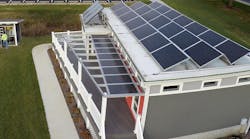Missouri University of Science and Technology, Rolla, Mo., has installed two new advanced lead battery microgrid systems at the campus’s EcoVillage, a “living laboratory” that is home to solar-powered houses designed and built by Missouri S&T students.
Members of Missouri S&T’s Microgrid Industrial Consortium want to use the microgrids to test advancements in lead battery energy storage for their potential use as a renewable energy source in communities of the future. Two homes occupied by students will be individually supplied with stored electricity from the systems, which run off charging algorithms from a 24-hr, cloud-based control system.
The Missouri S&T Microgrid Industrial Consortium is a collaborative research alliance that includes the Advanced Lead Acid Battery Consortium (ALABC), a research group and program of the International Lead Association (ILA); The Doe Run Co., a Missouri lead mining and battery recycling company; Ameren, Missouri’s largest energy utility provider; the Missouri Public Utility Alliance (MPUA); the Missouri Department of Economic Development Division of Energy (MO DED); and Missouri S&T’s Center for Research in Energy and Environment (CREE).
ALABC members NorthStar Battery and EnerSys, both global battery manufacturers, and The Doe Run Co. donated the equipment and funding to construct the new microgrids.
Dr. Mehdi Ferdowsi, director of Missouri S&T’s Microgrid Industrial Consortium and a professor of electrical engineering and computing, emphasizes that the new microgrid systems will allow researchers to explore the application of advanced lead batteries in stationary grid-tied applications, as most similar research to date has been with lithium batteries. “We’ll also be able to conduct research on potential peer-to-peer energy transactions that could result from this use — that is, the energy trading between consumers and ‘prosumers,’ those who both produce and consume the energy,” Ferdowsi says.
The project has a three-year timeline for research and study, and should be completed by 2021.
For more information, visit https://cree.mst.edu/laboratories/ecovillage.



